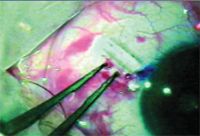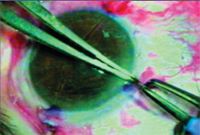Article
Trial finds laser presbyopia reversal beneficial for patients
Miami—Results from an international clinical trial including nearly 1,600 eyes indicate laser presbyopia reversal (LAPR) increases accommodation and improves near and intermediate vision with a benefit that is maintained for up to 5 years, said Richard S. Kalski, MD.

The procedure is designed to improve accommodation by expanding the scleral tissue in order to enhance the efficiency of the ciliary muscle and zonules. It is performed under topical anesthesia using an infrared erbium:YAG laser (OptiVision, SurgiLight) to create eight radial incisions in scleral tissue 0.5 mm posterior to the limbus.
The OptiVision laser had CE mark certification since the mid 1990s for other surgical and ophthalmic applications. LAPR gained CE mark certification in February 2005. The international clinical trial leading to that approval was launched in July 2000. At the time of CE filing in early 2004, data were reported from 50 clinical sites worldwide, including 23 in Pacific Rim countries, 10 in North America (including two U.S. centers), and nine in Europe. The enrolled patients are predominantly female (57%) and range in age from 45 to 74 years old (median, 61.3 years). A total of 318 eyes had been seen at 12 months and 85 were evaluated after 3 years.

"Patients are very happy with their near, intermediate, and distance vision after LAPR. They note restoration of their near vision immediately after surgery. LAPR seems to be associated with minimal complications, and as an added benefit, the surgery itself is technically straightforward. The procedure involves many techniques that are already familiar to ophthalmic surgeons, and so the learning curve is minimal and easily surmounted," said Dr. Kalski, medical monitor for the LAPR trial and a private practitioner in Miami, FL.

"One of the things we have seen with this procedure is that patients really need to try to read without their reading glasses in order to achieve the best effect, and they need to keep up that effort in order to maintain it," Dr. Kalski said.
The primary efficacy endpoint of the study for the CE filing evaluated the proportion of patients with J3 or better uncorrected near vision at 1 year. For the total 1,582 enrolled eyes, mean J score preoperatively was 7.7, and it improved to 3.5 at 10 days after LAPR. Among more than 1,000 eyes seen at 3 months, the mean J score was 2.9, and it was 3.0 for the eyes seen at 12 months. Eighty-one percent of eyes were J3 or better at 1 year, and 98% of eyes had 1 D or more improvement in accommodation. At both 2 and 3 years, mean J score was 2.7.
Newsletter
Don’t miss out—get Ophthalmology Times updates on the latest clinical advancements and expert interviews, straight to your inbox.





